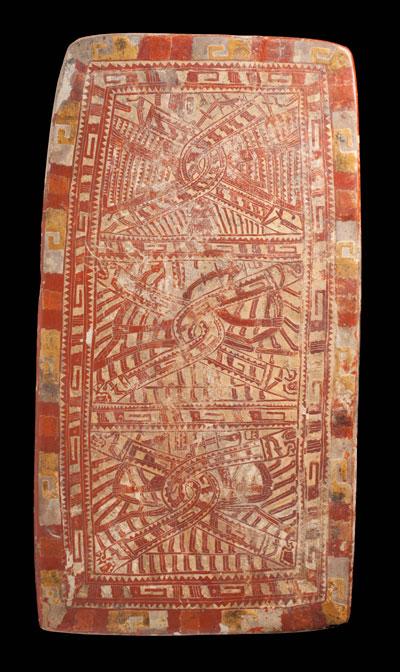This weekend LACMA added eight new works to its collection through its annual Collectors Committee events. All week on Unframed our curators will be highlighting the objects just acquired.

Painted Panel, Mexico, Oaxaca/Guerrero border region, 1200–1400, gift of the 2011 Collectors Committee
Rare in its scale and in its elaborate imagery, this painted panel derives from an archaeologically little-known area of southwestern Mexico. Its palette of strong primary colors and the prominent use of step-fret imagery throughout its composition, however, identify it as an extraordinary example of the artistic tradition referred to as the International Style, which dominated Mesoamerica during the Late Postclassic period (AD 1200–1400). The International Style originated in the present-day states of Oaxaca and Puebla and spread throughout much of Mexico via an extensive network of commercial and cultural trade routes. These networks, closely linked to the veneration of Quetzalcoatl, the Plumed Serpent, transcended ethnic identities and united disparate areas of Mesoamerica.
The unique aesthetic of the International Style characterizes work in all media from this period. Its specific motifs appear across Mexico, from ceramics from the Pacific coastal state of Nayarit to the murals of Mayapan in the heart of the Yucatan Peninsula to the turquoise mosaics produced in Oaxaca, testifying to the extent to which royal houses were driven to seek new materials in order to maximize the value of their works within the highly competitive gift economy that supported their political alliances. The style also characterizes the system of pictorial communication that allowed peoples speaking diverse languages to communicate with each other and to participate in a widely shared set of religious practices and beliefs.
The face of this panel is divided into three registers, each showing a composite human-serpent figure as its central motif. The intertwined pairs of serpents in each register are animated with human arms and hands, each of which holds a sinuous serpent, while another serpent emerges from the “knot” of each intertwined pair. The registers are framed with a step-fret design painted in red on a white background after the ceramic panel was fired. The geometric pattern of the outer frame reveals the unusual use of brilliant yellow and orange pigments as well as red. The reverse side is severly eroded, suggesting that it may have been in contact with organic matter such as paper, cloth, or human remains, but the painted vestiges of a single richly dressed human figure are still visible.
Within the geographic range of the International Style, the artistic and cultural origins of the panel is confirmed by comparing it to ceramic vessels recovered by UCLA archaeologist Clement Meighan during his excavations at Amapa, Nayarit in the 1950s. Like the panel, many of the objects feature intertwined serpents and step-fret designs and were painted after firing in the same strong primary color scheme. The origins and spread of the International Style is a primary topic of the upcoming exhibition Children of the Plumed Serpent: The Legacy of Quetzalcoatl in Ancient Mexico, opening in April 2012, in which the painted panel will figure prominently.
Virginia Fields, Senior Curator and Co-Department Head, Latin American Art



